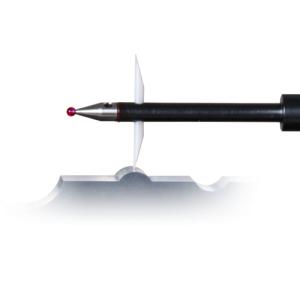ConturoMatic series:
simply overcoming boundaries
The connection between the X and Z measuring axes in a drive unit always leads to narrow tolerances.




The connection between the X and Z measuring axes in a drive unit always leads to narrow tolerances.
The feed axis assumes the function of the tool receptacle while the Z-axis just performs the scanning movement. Since both axes are motorised, this leads to enormous benefits.
Independent of the contour incline, both axes are controlled to keep the measurement speed constant. Classic combined drive units only move at constant speeds along X which invariably leads to increased measuring point distances along steep contour sections.
This irregularity in data point equality always leads to mathematical problems that can only be solved with interpolation (algorithmically generating interim values).
Our solution automatically leads to more consistent data point distances.
Calculation of parameters therefore always takes place using real, physically recorded, measured values. Furthermore, the Z-movement of a straight line is guided. There is no limitation of the measuring path any more, as is caused by the circular motion of the tracing arm of conventional drive units. Our tracing arm is almost always set horizontally. The probe tip can follow the contour dynamically throughout the measuring range of up to 280 x 350 mm, and the scanning conditions are clearly defined within the entire measuring range.
Since the probe tip position is precisely defined and repeatable to within a fraction of a millimetre, secure and automatic measurement is possible even in the smallest of bores.
Additionally, guide deviations of the Z-axis, which commonly result in measuring errors due to the lever effect of the tracing arm length, are automatically compensated for by our concept.
The concept behind all ConturoMatic TS systems comprises, first and foremost, two motorised measuring axes. The X-axis carries the sample and the Z-axis scans the contours. Both measured value recording and control are strictly based on state-of-the-art digital technology. The mechanical base is high-quality granite.
The effect:
Due to the use of precision parts within our systems, there is no need for expensive and overly complicated error correction. Stability and longevity are basic elements of our ConturoMatic products. New, different, innovative and technically revolutionary.
The technical innovations that make our new TS system the best device in its class include the integrated, maintenance-free electromechanical system for tracing force adjustment. Using this function, the tracing force can be adjusted for the contour and roughness modes of each tracing arm. These settings are individually determined for each tracing arm, managed by the software and automatically adjusted according to the required measurement function. To calibrate the tracing arm and the offset between the upper and lower probe tip, only the ball standard, which is included in the scope of supply, is required.
Due to the geometrically precise horizontal position of the tracing arm, it is possible to check contours and bores with a diameter of less than 2 mm to more than 300 mm. Breakage of the probe tip is minimised by the integrated safety shutdown of the Z-axis movement. The roughness analysis option, which is activated through the integrated measuring force setting, can be used in combination with the contour analysis. In many cases, this makes further measuring superfluous. Contour and roughness results can be effectively determined in a single step. Other tasks that can be performed by our ConturoMatic-TS include the analysis of bores, distances from inner to outer contours, taper angle and parallelism, profile defects and the measurement of discontinuous surfaces, with no loss of reference measurement.
Ergebnisdarstellung
Technische Highlights der ConturoMatic Serie:

Two-way tracing arm